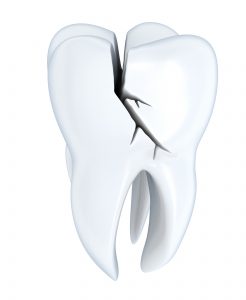 When most people think about getting dental work, they think of having a cavity filled or getting a checkup. But did you know that teeth develop cracks and fractures nearly as often as they get cavities? Every tooth has to have a sound structure – otherwise, you risk pain and sensitivity when you chew as well as breaking the tooth again down the road. And although it’s alarming to find out that you’ve cracked a tooth, there are multiple treatments that will restore your teeth’s strength, function and appearance. A dentist may recommend fillings, dental crowns or implants, depending on how large the crack is. Keep reading to find out more!
When most people think about getting dental work, they think of having a cavity filled or getting a checkup. But did you know that teeth develop cracks and fractures nearly as often as they get cavities? Every tooth has to have a sound structure – otherwise, you risk pain and sensitivity when you chew as well as breaking the tooth again down the road. And although it’s alarming to find out that you’ve cracked a tooth, there are multiple treatments that will restore your teeth’s strength, function and appearance. A dentist may recommend fillings, dental crowns or implants, depending on how large the crack is. Keep reading to find out more!
Small Cracks
When a dentist does an exam, they’re looking for any damage to the teeth such as cavities or cracks. And, if any damage has occurred, they look at how much of the tooth’s structure is affected.
For small chips or cracks that only affect the outer layer of a tooth (called enamel), a simple filling is often enough to repair the tooth. Here, a white filling material is used to either seal over a crack or replace a chipped or missing part of a tooth.
Moderate Cracks
If the tooth has a moderate-sized crack or a larger piece of it has broken off, a dental crown will restore its size, shape and strength. If the crack is severe and has reached the nerve of the tooth, a root canal may be necessary before the crown is placed.
Also, unless you opt for a gold crown, the crown will be matched in color to the rest of your smile so it blends in seamlessly.
Severe Cracks
In many cases, a severe crack or a crack that runs vertically will make a tooth unsalvageable. But that doesn’t mean hope is lost! After the tooth has been extracted, a dental implant can be placed that will look and function very much like tooth did before it became cracked.
The implant itself is a titanium post that’s placed in the jaw to replace a missing root. This is what sets implants apart from other options like bridges and provides unmatched strength, stability and longevity.
After the implant has fused with the surrounding jawbone, which usually takes 3-6 months, a dental crown is attached to complete the restoration.
It’s natural to feel concerned when you have a cracked tooth, but one of these options will restore your tooth so well that you’ll soon forget it ever had a problem to begin with!
About the Author
With over 35 years of experience, Dr. Mark Farthing is a general, cosmetic and restorative dentist who has successfully treated countless cracked teeth. He always carefully evaluates every case to make the best and most conservative recommendation for each patient. If you have a cracked tooth and have any other questions, he can be reached via his website or at (317) 898-3384.


